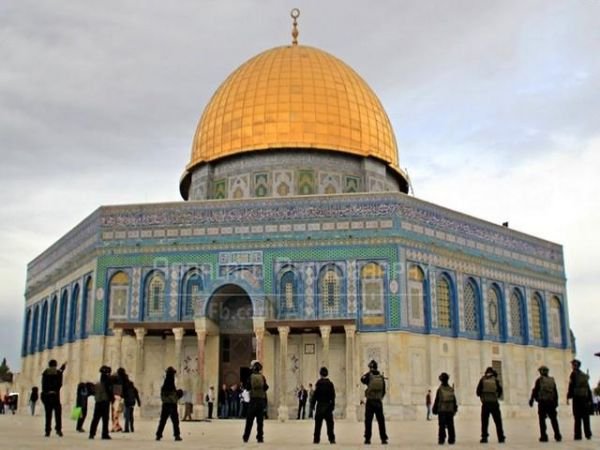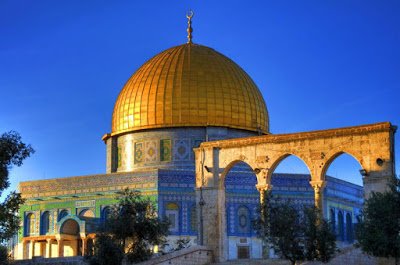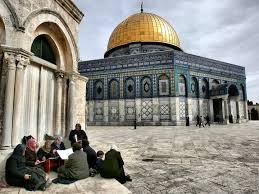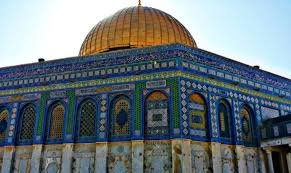
.
Location
Old City, Jerusalem
Established
705 CE
Administration
Waqf
Leadership
Imam(s):
Yousef Abu Sneineh
Muhammad Ahmad Hussein
Ekrima Sa'id Sabri
Architectural information
Style
Early Islamic, Mamluk
Capacity
5,000
Dome(s)
2
Minaret(s)
4
Minaret height
37 meters (121 ft) (tallest)
Materials
Limestone (external walls, minaret, facade) stalactite (minaret), lead (dome), white marble (interior columns)
Al-Aqsa Mosque:also known as al-Aqsa, is an Islamic holy place in the Old City of Jerusalem. The site that includes the mosque (along with the Dome of the Rock) is also referred to as al-Haram ash-Sharif or "Sacred Noble Sanctuary", a site also known as the Temple Mount, the holiest site in Judaism, the place where the First and Second Temples are generally accepted to have stood.[1][2] Widely considered as the third holiest site in Sunni Islam, Muslims believe that Muhammad was transported from the Sacred Mosque in Mecca to al-Aqsa during the Night Journey.[3] Islamic tradition holds that Muhammad led prayers towards this site until the seventeenth month after the emigration, when God ordered him to turn towards the Ka'aba.[4]
According to Islamic belief, Jacob, son of Isaac, was the first to build the Mosque as a House of God. The Kaaba in Mecca was the first House of Worship to God, and the Masjid Al-Aqsa (Bayt Al-Maqdis) was the second. Originally built by Jacob and greatly expanded and renovated by King Solomon, the Mosque was destroyed twice.
The al-Aqsa Mosque was originally a small prayer house built by the Rashidun caliph Umar, but was rebuilt and expanded by the Ummayad caliph Abd al-Malik and finished by his son al-Walid in 705 CE.[5] After an earthquake in 746, the mosque was completely destroyed and rebuilt by the Abbasid caliph al-Mansur in 754, and again rebuilt by his successor al-Mahdi in 780. Another earthquake destroyed most of al-Aqsa in 1033, but two years later the Fatimid caliph Ali az-Zahir built another mosque which has stood to the present-day. During the periodic renovations undertaken, the various ruling dynasties of the Islamic Caliphate constructed additions to the mosque and its precincts, such as its dome, facade, its minbar, minarets and the interior structure. When the Crusaders captured Jerusalem in 1099, they used the mosque as a palace and church, but its function as a mosque was restored after its recapture by Saladin. More renovations, repairs and additions were undertaken in the later centuries by the Ayyubids, Mamluks, Ottomans, the Supreme Muslim Council, and Jordan. Today, the Old City is under Israeli control, but the mosque remains under the administration of the Palestinian-led Islamic waqf.
Etymology":
Masjid al-Aqsa translates from Arabic into English as "the farthest mosque", Its name refers to a chapter of the Qur'an called "The Night Journey" in which it is said that Muhammad traveled from Mecca to "the farthest mosque", and then up to Heaven on a flying beast called al-Buraq al-Sharif.[6][7] "Farthest" as used in this context means the "farthest from Mecca."
For centuries, al-Masjid al-Aqsa referred not only to the mosque, but to the entire sacred sanctuary. This changed during the period of Ottoman rule (c. early 16th century to 1918) when the sanctuary complex came to be known as al Haram ash-Sharif, and the mosque founded by Umar came to be known as al-Jami' al-Aqsa or al-Aqsa Mosque.
History:
Pre-construction:
The Mosque is located in the Temple Mount enclosure expanded by King Herod the Great beginning in 20 BCE. Residing on an artificial platform, the mosque is supported by arches constructed by Herod's engineers to overcome the difficult topographic conditions resulting from the southward expansion of the enclosure into the Tyropoeon and Kidron valleys. At the time of the Second Temple, the present site of the mosque was occupied by the Royal Stoa, a basilica running the southern wall of the enclosure.[10] The Royal Stoa was destroyed along with the Temple during the sack of Jerusalem by the Romans in 70 CE. Emperor Justinian built a Christian church on the site in the 530s which was consecrated to the Virgin Mary and named "Church of Our Lady". The church was later destroyed by Khosrau II, the Sassanian emperor, in the early 7th century and left in ruins.]
Construction by the Umayyads:
The mosque along the southern wall of the Temple Mount
It is unknown exactly when the al-Aqsa Mosque was first constructed and who ordered its construction, but it is certain that it was built in the early Ummayad period of rule in Palestine. Architectural historian K. A. C. Creswell, referring to a testimony by the Gallicmonk, Arculf, of his pilgrimage to Palestine in 679–82, notes that it is possible that Umar erected a primitive quadrangular building for a capacity of 3,000 worshipers somewhere on the Haram ash-Sharif or Temple Mount. Arculf, however, visited Palestine during the reign of Mu'awiyah I, and it is possible that Mu'awiyah ordered the construction, not Umar. This latter claim is explicitly supported by the early Muslim scholar al-Muthahhar bin Tahir.[12] Analysis of wooden beams and panels removed from the building during renovations in the 1930s shows they are made from Cedar of Lebanon and cypress. Radiocarbon dating indicates a large range of ages, some as old as 9th century BCE, showing that some of the wood had previously been used in older buildings.
According to several Muslim scholars, including Mujir ad-Din, al-Suyuti, and al-Muqaddasi, the mosque was reconstructed and expanded by the caliph Abd al-Malik in 690 along with the Dome of the Rock.[12][14] Guy le Strange claims that Abd al-Malik used materials from the destroyed Church of Our Lady to build the mosque and points to possible evidence that substructures on the southeast corners of the mosque are remains of the church.[14] In planning his magnificent project on the Temple Mount, which in effect would turn the entire complex into the Haram al-Sharif ("the Noble Sanctuary"), Abd al-Malik wanted to replace the slipshod structure described by Arculf with a more sheltered structure enclosing the qibla, a necessary element in his grand scheme. However, the entire Haram al-Sharif was meant to represent a mosque. How much he modified the aspect of the earlier building is unknown, but the length of the new building is indicated by the existence of traces of a bridge leading from the Umayyad palace just south of the western part of the complex. The bridge would have spanned the street running just outside the southern wall of the Haram al-Sharif to give direct access to the mosque. Direct access from palace to mosque was a well-known feature in the Umayyad period, as evidenced at various early sites. Abd al-Malik shifted the central axis of the mosque some 40 meters (131 ft) westward, in accord with his overall plan for the Haram al-Sharif. The earlier axis is represented in the structure by the niche still known as the "mihrab of 'Umar". In placing emphasis on the Dome of the Rock, Abd al-Malik had his architects align his new al-Aqsa Mosque according to the position of the Rock, thus shifting the main north–south axis of the Temple Mount, a line running through the Dome of the Chain and the Mihrab of Umar.
In contrast, Creswell, while referring to the Aphrodito Papyri, claims that Abd al-Malik's son, al-Walid I, reconstructed the Aqsa Mosque over a period of six months to a year, using workers from Damascus. Most scholars agree that the mosque's reconstruction was started by Abd al-Malik, but that al-Walid oversaw its completion. In 713–14, a series of earthquakes ravaged Jerusalem, destroying the eastern section of the mosque, which was subsequently rebuilt during al-Walid's rule. In order to finance its reconstruction, al-Walid had gold from the dome of the Rock minted to use as money to purchase the material.[12] the Umayyad-built al-Aqsa Mosque most likely measured 112 x 39 meters.[15]
Earthquakes and re-construction:
The facade and porch of the mosque were constructed and expanded by the Fatimids, the Crusaders, the Mamluks and the Ayyubids
In 746, the al-Aqsa Mosque was damaged in an earthquake, four years before as-Saffah overthrew the Ummayads and established the Abbasid Caliphate. The second Abbasid caliph Abu Ja'far al-Mansur declared his intent to repair the mosque in 753, and he had the gold and silver plaques that covered the gates of the mosque removed and turned into dinars and dirhams to finance the reconstruction which ended in 771. A second earthquake damaged most of al-Mansur's repairs, excluding those made in the southern portion in 774.[14][16] In 780, the successor caliph Muhammad al-Mahdi had it rebuilt, but curtailed its length and increased its breadth.[14][17] Al-Mahdi's renovation is the first known to have written records describing it. In 985, Jerusalem-born Arab geographer al-Muqaddasi recorded that the renovated mosque had "fifteen naves and fifteen gates".
In 1033, there was another earthquake, severely damaging the mosque. The Fatimid caliph Ali az-Zahir rebuilt and completely renovated the mosque between 1034 and 1036. The number of naves was drastically reduced from fifteen to seven. Az-Zahir built the four arcades of the central hall and aisle, which presently serve as the foundation of the mosque. The central aisle was double the width of the other aisles and had a large gable roof upon which the dome—made of wood —was constructed.[12]
Jerusalem was captured by the Crusaders in 1099, during the First Crusade. Instead of destroying the mosque—which they called "Solomon's Temple"—the Crusaders used it as a royal palace and as a stable for horses. In 1119, it was transformed into the headquarters for the Templar Knights. During this period, the mosque underwent some structural changes, including the expansion of its northern porch, and the addition of an apse and a dividing wall. A new cloister and church were also built at the site, along with various other structures.[19] The Templars constructed vaulted western and eastern annexes to the building; the western currently serves as the women's mosque and the eastern as the Islamic Museum.[16]
After the Ayyubids under the leadership of Saladin reconquered Jerusalem after besieging it in 1187, several repairs were undertaken at al-Aqsa Mosque.[21] Saladin's predecessor—the Zengid sultan Nur al-Din—had commissioned the construction of a new minbar or "pulpit" made of ivory and wood in 1168–69, but it was completed after his death; Nur ad-Din's minbar was added to the mosque in November 1187 by Saladin.[22] The Ayyubid sultan of Damascus, al-Mu'azzam, built the northern porch of the mosque with three gates in 1218. In 1345, the Mamluks under al-Kamil Shaban added two naves and two gates to the mosque's eastern side.[16]
After the Ottomans seized power in 1517, they did not undertake any major renovations or repairs to the mosque itself, but they did to the Temple Mount as a whole. This included the building of the Fountain of Qasim Pasha (1527), the restoration of the Pool of Raranj, and the building of the three free-standing domes—the most notable being the Dome of the Prophet built in 1538. All construction was ordered by the Ottoman governors of Jerusalem and not the sultans themselves.[23] The sultans did make additions to existing minarets, however.[23]
Modern era:
The dome of the mosque in 1982. It was made of aluminum (and looked like silver), but replaced with its original lead plating in 1983
The first renovation of the 20th century occurred in 1922, when the Supreme Muslim Council under Amin al-Husayni hired Ahmet Kemalettin Bey—a Turkish architect—to restore al-Aqsa Mosque and the monuments in its precincts. The council also commissioned British architects, Egyptian experts and local officials to contribute to and oversee the repairs and additions which were carried out in 1924–25 under Kemalettin's supervision. The renovations included reinforcing the mosque's ancient Ummayad foundations, rectifying the interior columns, replacing the beams, erecting a scaffolding, conserving the arches and drum of the dome interior, rebuilding the southern wall, and replacing timber in the central nave with a slab of concrete. The renovations also revealed Fatimid-era mosaics and inscriptions on the interior arches that had been covered with plasterwork. The arches were decorated with green-tinted gypsum and gold and their timber tie beams were replaced with brass. A quarter of the stained glass windows also were carefully renewed so as to preserve their original Abbasid and Fatimid designs.[24] Severe damage was caused by the 1927 and 1937 earthquakes, but the mosque was repaired in 1938 and 1942.
Inscription above Qibla, Aqsa mosque, depicting Fatimid
The mosque seen from the Western Wall plaza, 2005
On August 21, 1969, a fire occurred inside al-Aqsa Mosque that gutted the southeastern wing of the mosque. Among other things, the fire destroyed Saladin's minbar.[22] Initially, Palestinians blamed the Israeli authorities for the fire, and some Israelis blamed Fatah, alleging they had started the fire so as to blame the Israelis and provoke hostility. However, the fire was started by neither Fatah nor Israel, but a tourist from Australia named Denis Michael Rohan. Rohan was a member of an evangelical Christian sect known as the Worldwide Church of God.[25] He hoped that by burning down al-Aqsa Mosque he would hasten the Second Coming of Jesus, making way for the rebuilding of the Jewish Temple on the Temple Mount. Rohan was hospitalized in a mental institution, found to be insane and was later deported.[26] The attack on al-Aqsa is cited as one of the catalysts for the formation of the Organization of the Islamic Conference in 1971, which brought together 57 Islamic countries.]In the 1980s, Ben Shoshan and Yehuda Etzion, both members of the Gush Emunim Underground, plotted to blow up the al-Aqsa mosque and the Dome of the Rock. Etzion believed that blowing up the two mosques would cause a spiritual awakening in Israel, and would solve all the problems of the Jewish people. They also hoped the Third Temple of Jerusalem would be built on the location of the mosque.[28][29] On January 15, 1988, during the First Intifada, Israeli troops fired rubber bullets and tear gas at protesters outside the mosque, wounding 40 worshipers.[30][31] On October 8, 1990, 22 Palestinians were killed and over 100 others injured by Israeli Border Police during riots that were triggered by the announcement of the Temple Mount Faithful, a fringe group of religious Jews, that they were going to lay the cornerstone of the Third Temple.[32][33]
Architecture:
The rectangular al-Aqsa Mosque and its precincts are 144,000 square meters (1,550,003.1 sq ft), although the mosque itself is about 35,000 square meters (376,736.9 sq ft) and could hold up to 5,000 worshipers.[34][35] It is 272 feet (83 m) long, 184 feet (56 m) wide.



Hi! I am a robot. I just upvoted you! I found similar content that readers might be interested in:
https://en.wikipedia.org/wiki/Al-Aqsa_Mosque